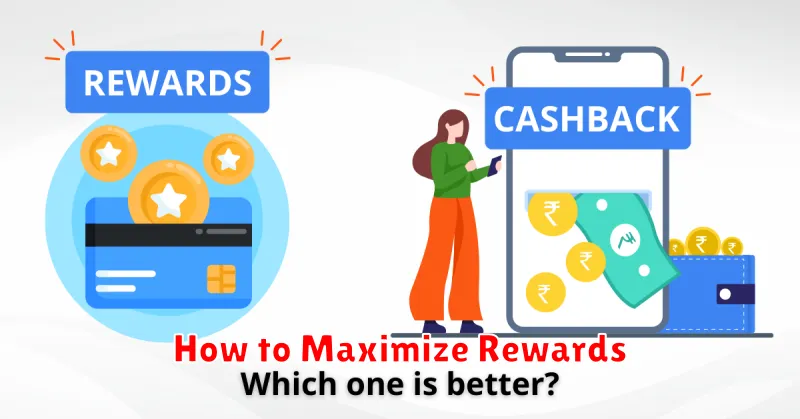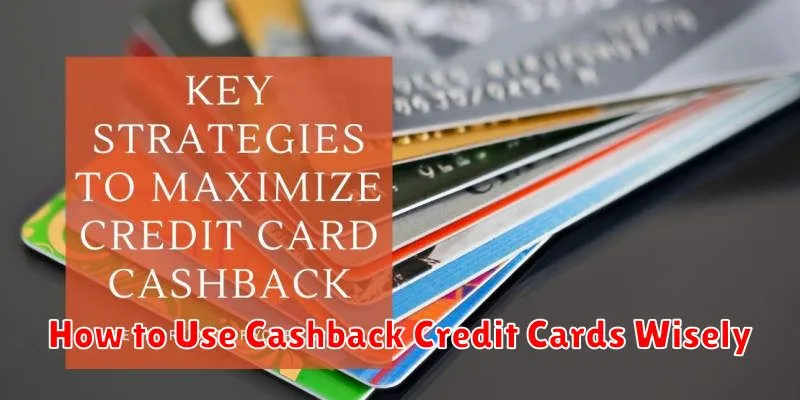Cashback credit cards can be a powerful tool to save money and earn rewards on everyday purchases. However, using them wisely is crucial to avoid falling into debt and maximizing their benefits. This article will explore the essential strategies for using cashback credit cards effectively, allowing you to reap the rewards while maintaining financial responsibility. We’ll cover everything from choosing the right cashback credit card to managing your spending and redeeming your cashback earnings. Understanding these key principles will empower you to make informed decisions and unlock the true potential of cashback credit cards.
Are you ready to turn your everyday spending into cashback rewards? Learn how to choose a cashback credit card that aligns with your spending habits, avoid common pitfalls like overspending, and strategize your cashback redemption for maximum value. From maximizing rewards categories to understanding the fine print, this guide will provide you with the knowledge and tools to use cashback credit cards wisely and achieve your financial goals.
What Are Cashback Credit Cards?
Cashback credit cards are a type of rewards credit card that returns a percentage of your spending as cash back. Every time you make a purchase, a certain percentage, typically between 1% and 5%, is credited back to your account. This cashback can often be redeemed in various ways, such as a statement credit, direct deposit, or check.
There are different types of cashback cards. Some offer a flat-rate cashback on all purchases, making them simple and straightforward to use. Others provide tiered cashback, offering higher percentages on specific spending categories like groceries, gas, or dining. Some cards even offer rotating bonus categories, requiring cardholders to activate the bonus each quarter to maximize their rewards.
While cashback credit cards offer a tangible reward, it’s essential to consider other factors like annual fees, interest rates, and other potential benefits before choosing a card. Ensure you choose a card that aligns with your spending habits and financial goals to maximize the rewards you earn.
Types of Cashback Programs
Cashback programs reward customers for their purchases by returning a percentage of the amount spent. These programs come in various forms, each offering unique benefits and redemption options. Understanding these different types is crucial for maximizing your savings potential.
Credit card cashback is a popular option where a percentage of every purchase made with the card is credited back to the cardholder. Some cards offer a flat cashback rate on all purchases, while others offer tiered rates based on spending categories, such as groceries or gas. Retailer-specific cashback programs, offered by individual stores or brands, reward customer loyalty with cashback on purchases made directly with them. These programs may involve a store credit card, a loyalty card, or even automatic cashback credited to an account.
Finally, online cashback portals act as intermediaries between shoppers and online retailers. By clicking through a portal before making a purchase, customers can earn a percentage of their spending back. These portals often partner with hundreds of retailers, providing a wide range of shopping options and cashback opportunities. Choosing the right type of cashback program depends on individual spending habits and preferences.
Choosing the Right Card for Your Lifestyle
Selecting the right credit card can significantly impact your financial well-being. Consider your spending habits. Are you a frequent traveler? Do you prioritize cashback rewards? Perhaps low interest rates are your primary concern. Analyzing your needs will narrow down the options and help you identify the most beneficial card.
Compare various card features. Look beyond the introductory offers. Pay attention to the ongoing APR, annual fees, and any associated perks. Consider factors like foreign transaction fees if you travel internationally. Some cards offer specific rewards categories, such as dining or groceries, which may align better with your spending patterns. Researching different card options will empower you to make an informed decision.
Finally, evaluate your credit score. Your creditworthiness plays a crucial role in determining your eligibility for specific cards and the interest rates you’ll receive. A higher credit score often unlocks access to premium cards with better benefits. Understanding your credit standing will help you choose a card that is both attainable and advantageous.
How to Maximize Rewards

Maximizing rewards involves a strategic approach to earning and redeeming points, miles, or cash back. Understanding the terms and conditions of your rewards program is crucial. This includes knowing earning rates for different spending categories, redemption options, and any expiration policies. Focus your spending on categories offering bonus rewards and consider using affiliated cards for everyday purchases like groceries and gas to accelerate your earnings.
Redeeming your rewards strategically is equally important. Compare the value of different redemption options, such as merchandise, gift cards, travel, or cash back. Often, travel redemptions offer the highest value per point or mile, particularly for premium cabin flights or hotel stays. Avoid redeeming for options that offer significantly lower value, unless absolutely necessary.
Finally, stay organized. Track your rewards balances, monitor for limited-time promotions, and set a goal for what you want to redeem your rewards for. This can help you stay motivated and maximize the return on your spending.
Avoiding Interest and Fees
Interest and fees can significantly impact your finances. To avoid unnecessary expenses, understand the terms and conditions of your financial products. For credit cards, pay your balance in full and on time each month. This prevents accruing interest charges. For loans, make sure you understand the interest rate, repayment schedule, and any associated fees. Create a budget and stick to it to ensure you can afford your payments. Paying attention to these details can save you substantial money over time.
Bank accounts can also incur fees. Overdraft fees are common and can be easily avoided by monitoring your account balance and ensuring you have sufficient funds. Many banks offer low-fee or no-fee checking accounts. Researching different options and choosing the right account for your needs can help minimize fees. Consider setting up low balance alerts to help you avoid overdraft charges.
Beyond credit cards and bank accounts, be aware of other potential fees. Late payment fees on utilities, subscriptions, or other bills can add up. Automate payments whenever possible to ensure timely payment and avoid these charges. Read the fine print on any agreement or contract to understand all potential fees. By being proactive and informed, you can effectively minimize unnecessary interest and fees.
When to Redeem Cashback
Deciding when to redeem your cashback depends on the specific program’s terms and your personal financial goals. Some programs may have expiration dates or redemption thresholds, so it’s crucial to understand these rules. If your cashback is expiring soon, redeeming it is obviously the best choice. Similarly, if you’ve reached a minimum redemption amount, it might be wise to cash out to avoid losing any potential rewards.
If there are no pressing deadlines, consider your current financial needs. Do you have any immediate expenses or upcoming bills? Redeeming your cashback could provide a helpful buffer. Alternatively, if you’re saving for a specific goal, such as a down payment or a vacation, letting your cashback accumulate could help you reach your target faster. Ultimately, the best time to redeem depends on your individual circumstances and priorities.
Some programs offer bonus rewards for redeeming at certain times or for specific purchases. For example, you might earn extra points or a higher cashback percentage during promotional periods. Keeping an eye out for these opportunities can maximize the value of your rewards.
Alternatives to Cashback Cards
While cashback cards offer a simple and attractive reward, they aren’t the only option. If you’re looking to maximize your credit card benefits, consider alternatives such as travel rewards cards. These cards allow you to earn points or miles redeemable for flights, hotels, and other travel expenses. They often come with additional perks like airport lounge access or free checked bags, making them a good choice for frequent travelers. Another alternative is points rewards cards. These cards offer a more flexible rewards system, allowing you to redeem points for a variety of options, including merchandise, gift cards, or even statement credits.
For those focused on minimizing interest payments, a low-interest card can be a powerful tool. These cards offer significantly lower APRs than standard credit cards, which can translate to substantial savings over time, especially for those who carry a balance. They are a great choice for individuals prioritizing debt management or making large purchases. Keep in mind, low-interest cards typically don’t offer rewards programs as robust as cashback or travel cards.
Finally, consider secured credit cards. These cards are designed for those with limited or no credit history. They require a security deposit which typically becomes your credit limit. By responsibly using a secured card and making on-time payments, you can build a positive credit history and eventually qualify for other credit card options. While secured cards may not offer the highest rewards or lowest interest rates, they are a valuable tool for establishing credit.
Is It Worth It for You?
Determining worth is a highly personal process. It depends on your individual values, goals, and circumstances. What one person finds valuable, another may deem insignificant. To assess worth, carefully weigh the costs and benefits, both tangible and intangible. Consider the short-term and long-term implications of your decision.
Think about your priorities. Does this align with what truly matters to you? Will it contribute to your overall well-being and bring you closer to your desired outcome? It’s essential to be honest with yourself about your needs and expectations. Don’t let external pressures or societal norms influence your judgment.
Ultimately, the question of “is it worth it?” requires introspection and careful consideration. By evaluating the potential impact on your life, you can make an informed decision that aligns with your personal values and goals. Remember, only you can determine what truly holds value for you.

